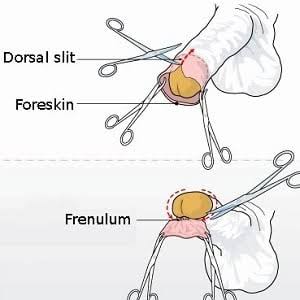
simply amazing, always for you.
Circumcision, the surgical removal of the foreskin covering the head of the penis, is a practice with deep roots in history, culture, religion, and medicine. Its importance varies significantly across societies and is influenced by personal beliefs, cultural norms, and medical advice. This article explores the multifaceted significance of circumcision, addressing its religious, cultural, medical, social, and ethical dimensions.

1. Religious and Cultural Significance
Circumcision is one of the oldest known surgical practices, with historical evidence dating back thousands of years. Its significance in religious and cultural contexts remains profound.
- Religious Observance:
In Judaism, circumcision, or “brit milah,” is performed on the eighth day after birth as a symbol of the covenant between God and Abraham. It is a deeply spiritual act that reflects obedience to divine commandments. Similarly, in Islam, circumcision, known as “khitan,” is considered an act of cleanliness and an important sunnah (tradition of the Prophet Muhammad). Though not explicitly mentioned in the Quran, it is widely practiced among Muslim communities. - Cultural Identity:
Beyond religion, circumcision is a rite of passage in many societies. For instance, in several African cultures, it signifies the transition from boyhood to manhood and is often accompanied by ceremonies that highlight bravery, maturity, and readiness to take on adult responsibilities. These rituals strengthen communal bonds and reinforce cultural identity.
2. Medical and Health Benefits
Circumcision has been associated with various health benefits, which are often cited as reasons for its practice. While these benefits are debated, medical studies provide substantial evidence supporting some of them.
- Reduced Risk of Urinary Tract Infections (UTIs):
In infancy, circumcised boys have a lower risk of UTIs, which, though uncommon, can lead to serious complications if untreated. - Protection Against Sexually Transmitted Infections (STIs):
Studies have shown that circumcision can reduce the risk of acquiring certain STIs, including HIV. This is particularly significant in regions like sub-Saharan Africa, where circumcision has been incorporated into public health strategies to combat the HIV epidemic. - Improved Hygiene:
The removal of the foreskin facilitates easier cleaning, reducing the likelihood of infections like balanitis (inflammation of the glans and foreskin). - Prevention of Phimosis and Paraphimosis:
Conditions like phimosis, where the foreskin cannot be retracted, and paraphimosis, where it becomes stuck behind the glans, are eliminated by circumcision. - Reduced Risk of Penile Cancer:
Though rare, penile cancer is less common among circumcised men. This may be linked to improved hygiene and reduced chronic inflammation.
While these benefits provide strong support for circumcision in specific contexts, they should be weighed against potential risks and ethical considerations.
3. Social and Psychological Considerations
Circumcision can also have social and psychological implications, particularly in societies where it is the norm.
- Conformity to Community Norms:
In communities where circumcision is widespread, being circumcised can prevent stigma or social exclusion. For example, boys growing up in such societies may face less teasing or bullying if they conform to the norm. - Aesthetic Preferences:
Some individuals and cultures prefer the appearance of a circumcised penis, which may influence personal or parental decisions. This preference can be tied to perceptions of cleanliness or societal expectations.
4. Public Health Strategies
In some regions, circumcision is promoted as a public health measure. For instance, the World Health Organization (WHO) and UNAIDS recommend circumcision as part of comprehensive HIV prevention programs in areas with high HIV prevalence. Large-scale campaigns in countries like South Africa, Kenya, and Uganda have successfully increased circumcision rates, contributing to a reduction in new HIV infections.
These public health initiatives emphasize voluntary medical male circumcision (VMMC), ensuring that individuals understand the procedure’s benefits and risks before making an informed decision.
5. Controversies and Ethical Considerations
Despite its perceived importance, circumcision is not without controversy. Critics argue that the procedure, especially when performed on infants or children, raises ethical questions about consent and bodily autonomy.
- Ethical Concerns:
Infant circumcision is performed without the individual’s consent, leading some to question its justification when no immediate medical need exists. Opponents advocate for delaying the procedure until the individual can make an informed choice. - Medical Risks:
Like any surgical procedure, circumcision carries potential risks, including bleeding, infection, and scarring. While complications are rare when performed by skilled practitioners, they highlight the importance of ensuring high standards of care. - Cultural Sensitivity:
Efforts to promote or discourage circumcision must consider cultural and religious sensitivities. Imposing or stigmatizing practices can lead to social conflict or resistance.
6. Personal and Family Decision-Making
For many families, the decision to circumcise a child involves balancing cultural traditions, medical advice, and personal beliefs. Parents may choose circumcision to align with family practices, religious duties, or perceived health benefits. In other cases, they may opt to forgo the procedure, citing ethical concerns or a preference for allowing the child to decide later in life.

In adult men, circumcision is often performed for medical reasons, such as treating phimosis, or as a personal choice based on hygiene or sexual health considerations.
Conclusion
Circumcision holds diverse meanings and significance depending on the context. For some, it is a deeply spiritual act rooted in religious obedience or cultural tradition. For others, it is a pragmatic health intervention aimed at reducing disease risk. While the practice offers several benefits, it also raises ethical and medical concerns that must be carefully weighed.
Ultimately, the importance of circumcision is subjective, shaped by individual, familial, and societal factors. Respect for personal choice and cultural diversity is essential in discussions surrounding this practice, ensuring that decisions are informed, consensual, and sensitive to varying perspectives.

Support Our Website!
We appreciate your visit and hope you find our content valuable. If you’d like to support us further, please consider contributing through the TILL NUMBER: 9549825. Your support helps us keep delivering great content!
Thank you for your generosity!
